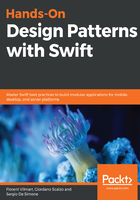
Using weak and unowned
Swift provides us with two keywords that indicate how we want to extend the lifetime of an object in a closure. While both prevent creating retain cycles, they are fundamentally different.
Using weak will wrap the captured value inside of an optional, indicating that the instance may have been deallocated before the closure was executed:
class MyClass {
var running = false
func run() {
running = true
DispatchQueue.main.asyncAfter(deadline: .now() + 10) { [weak self] in
self?.running = false
}
}
}
var instance: MyClass? = MyClass()
instance?.run()
instance = nil
In this execution, instance will immediately be deallocated when set to nil.
Using unowned indicates that the variable won't be owned by the block. Another mechanism should be responsible for ensuring that the lifetime of the captured object is properly extended until the block is executed:
class MyClass {
var running = false
func run() {
running = true
DispatchQueue.main.asyncAfter(deadline: .now() + 10) { [unowned self] in
self.running = false
}
}
}
var instance: MyClass? = MyClass()
instance?.run()
instance = nil
In this case, your program will crash when the block is executing, because the self variable will be deallocated upon the execution of the block:
Fatal error: Attempted to read an unowned reference but object 0x7f80bc75a4e0 was already deallocated